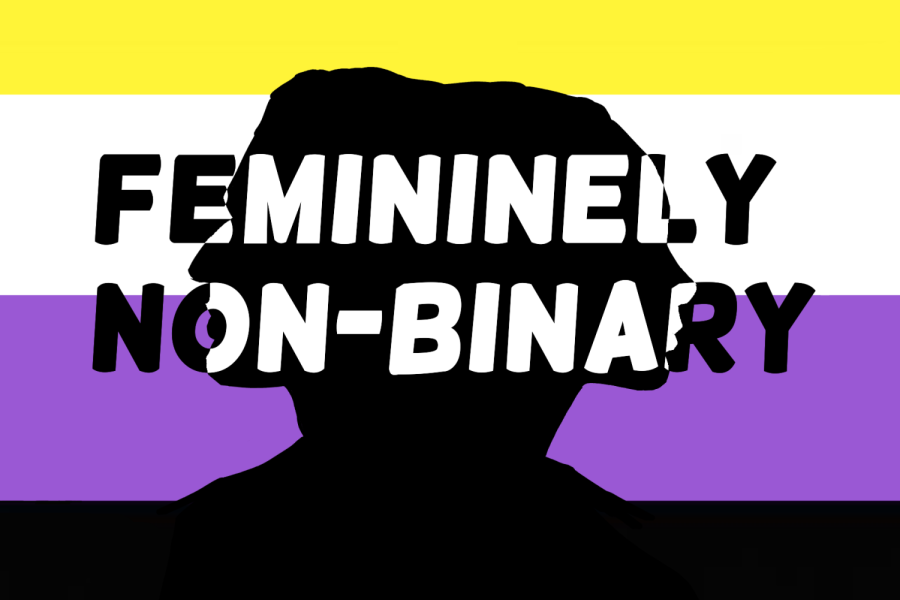Femininely non-binary
Clothing influences how we view others, from if we want to be friends with them to what bands they like to what gender they are. But what happens when you identify as one thing, but because of your clothes people think of you as something else?
Femininely Non-Binary art by Rosellyn Rubio
There’s an interesting paradox that comes with being assigned female at birth, identifying as non-binary and being typically feminine-presenting.
Everyone subconsciously identifies everyone else as a specific gender in their heads: fact. To be clear, gender and sex are not the same thing. Gender is an identity, sex is assigned at birth with the reproductive parts one is born with. People who are cisgender are those who identify as the gender that aligns with the sex assigned at birth, i.e. you’re a girl and were assigned female at birth.
With thousands of years of fashion trends that changed with how we viewed gender, it’s no surprise that specific articles of clothing have become something people use to identify the gender of the person wearing said clothes. Of course with the rise in LGBTQ+ rights movements spreading across the United States there’s a break in gender norms. With clothing becoming more about expression plays a key part in how people, especially transgender individuals, choose to present themselves. Trends emerged with labels- for example the whole ‘bisexual people cuff their jeans’ thing that went around social media during 2020-2021.
Androgyny is nothing new to the world. A person who hovers between femininity and masculinity, possessing traits for both characteristics. But something that is strikingly new is the validation of being androgynous and non-binary. People say that non-binary people don’t owe you androgyny, but is that really true?
As someone who is feminine presenting and goes by they/them pronouns, I find that a lot of people, even those in the LGBTQ+ community, do harbor the need for someone to be androgynous in order to be non gender conforming. If I had a nickel every time someone felt that my being entirely comfortable in my own body and gender expression meant I was someone not able to be non-binary, I’d have over a dollar in nickels, which might not seem like a lot but when you realize it takes 20 of those nickels to add up to a dollar it seems like a rather large number indeed. And those are just the one’s I’m aware of.
I like dresses, and skirts, and typically girlish things like tying ribbons into my hair and buying flowery corsets with lace lining. I enjoy dotting freckles onto my face and being feminine, being secure in the way I fill out a tight top and wearing the shortest shorts possible during the summertime when it’s way too hot to do anything else. I like my voice and the way my body looks, but none of this takes away from the simple fact I am still not a girl.
Dresses- something most view as inherently feminine- weren’t historically female. Neither were tights. Or skirts. Or makeup. Or wigs. Or—
You get the point.
It’s irritating, being seen as a girl when I’ve been out for almost three years. The way I know even people who are transgender might not see me as non-binary, not when their own expression revolves around gender conformity and dysphoria. And that’s not something I villainize them for- the way you choose to express yourself is entirely your own but that’s exactly it- your own. Not mine. Being feminine doesn’t make me any less transgender, and it doesn’t mean I’m somehow still a girl. I may not feel dysphoria but I know I will never be a girl.
If clothing were deconstructed, the ideas revolving around assigning pieces of fabric to a gender broken apart and held in loose terms of masculine and feminine, that’d be something really cool, I think. Because really, who decided a few feet of fabric fashioned to zip-up at the waist and fall around the legs was a girl thing?
Your donation will support the student journalists of West High School. Your contribution will allow us to purchase Scholarship Yearbooks, newsroom equipment and cover our annual website hosting costs.

(they/them) Jules is a senior and this is their second year on the West Side Story. They are the entertainment editor for the online publication. After...




